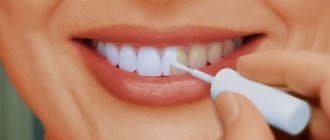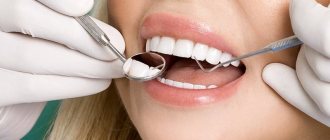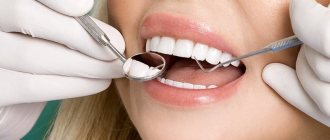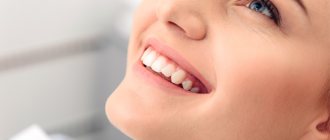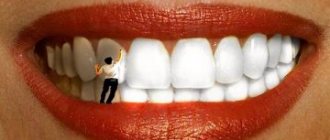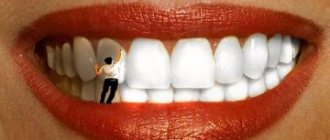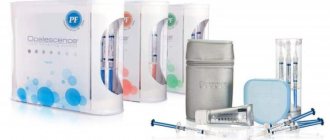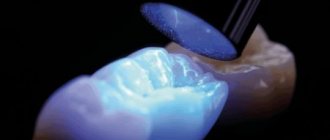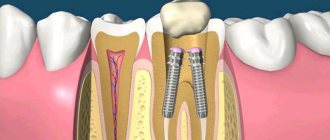Fluoridation of teeth refers to a procedure in which the tooth surface is actively saturated with fluoride ions. This helps strengthen teeth and reduce the risk of developing caries. If the body lacks an element such as fluoride, then the process of destruction of dental tissue occurs. It becomes less durable and is easily exposed to various factors.
The clinic in St. Petersburg performs a procedure to strengthen enamel for both adults and children. Since it is absolutely safe and harmless to the body.
What is dental fluoridation?
Fluoridation of teeth is an effective method of strengthening tooth enamel and protecting teeth from caries.
A deficiency of fluoride and calcium in the human body inevitably leads to the destruction of dentin (the main part of the tooth) and the enamel covering it. The result is increased tooth sensitivity, a tendency to develop caries, and periodontal disease.
Fluoridation is a painless and absolutely safe procedure, the essence of which is to apply a thin layer of fluoride-containing compounds (fluorides) to the surface of the teeth.
After fluoridation, it is recommended not to eat for several hours (4-6 depending on the drugs used), and also not to drink too hot or, conversely, cold drinks. In addition, you should refrain from eating solid food for 24 hours. These recommendations are due to the possibility of damaging the protective layer of fluoride applied to the teeth. If deep fluoridation has been carried out, you can eat and drink immediately.
Operating principle
The process is based on the ability of microscopic fluoride particles to penetrate deeply into the cavity of the tooth. At the same time, the dental crown is saturated with fluoride ions, closing the dentinal canals and forming a strong protective shell both on the surface and inside.
Fluorides are insoluble, they are not washed off for a long time, protecting the hard tissues of the tooth and pulp. Fluoride is, as it were, integrated into the tooth structure, restoring its integrity. In addition, the remineralization process starts.
Treatment is carried out using special fluoride-containing agents, which also have an antimicrobial effect.
They do not use fluorine in its pure form, but use its compounds: magnesium, calcium, copper fluorides. These elements are irreplaceable, they participate in the formation of hard tissues - enamel and dentin, and combine well with calcium.
The result lasts up to several years; for high efficiency, it is recommended to repeat the event every six months. Fluoridation is not only a preventive measure, it helps even in case of incipient caries.
You can see what your baby’s teeth will look like in the before and after photos:
Why coat your teeth with fluoride?
So what does fluoridation do? This method can be used by both adults and children to strengthen enamel and improve its strength properties.
Fluoride is an important element that not only makes enamel stronger, but also prevents the rapid proliferation of bacteria. Among other things, the resistance of teeth to an acidic environment increases, which means their surface becomes less susceptible to various types of destructive substances.
The fluoridation procedure must be repeated annually - then the teeth will be reliably protected from caries and not subject to premature destruction; The gradual leaching of calcium will stop, making the enamel stronger.
Reviews
Reviews of treatment using fluoride salts are mostly positive. Parents of young patients note the following:
- “It is very good that today fluoridation has replaced the silvering of teeth. It is much more effective, and most importantly, the teeth look normal and do not turn black, as when treated with silver.”
- “You shouldn’t give fluoridation to small children, they are constantly fidgeting, the procedure is performed poorly and does not bring the expected benefits. It’s better to brush your teeth with special toothpastes.”
- “Do not treat sick teeth, there will be no effect.”
- “Visit several different dentists, there are dishonest clinics that impose a service to make money, although there are no indications for its implementation.”
- “If a child is prone to frequent caries and tooth decay, fluoridation can be a lifesaver to prevent the child from becoming toothless.”
- “Fluoride treatment turned out to be ineffective, the caries deepened and spread to other teeth.”
- “The procedure is not bad, but it is not a panacea for caries; it is useless to treat diseased teeth.”
The opinion of specialists about the procedure is mostly positive. According to Evgeniy Olegovich Komarovsky, “fluoridation is a good means of preventing caries, but it does not cure it.”
Types of fluoridation
Currently, fluoridation of teeth is carried out using two methods - simple and deep:
- Simple fluoridation . To carry out the procedure, special “spoons” are used that look like mouth guards, which are filled with a fluoride-containing composition and placed on the jaw for 10-15 minutes. To complete the full course, you need to conduct at least 10 sessions. An alternative option is simple fluoridation using a fluoride-containing varnish. It is applied with a special brush to the surface of the teeth and allowed to dry. The full course consists of 3-4 procedures, depending on the individual characteristics of the body and the drug used.
- Deep fluoridation . The main difference between this method and the previous one is the use of special enamel-sealing preparations. In addition, deep fluoridation requires careful preparation of teeth, therefore it is carried out exclusively in professional clinics. After the stage of cleaning the teeth, a special composition is applied to their surface using a tampon for 1-2 minutes, after which it is dried under the pressure of warm air. Then the surface of the teeth is stained with a swab dipped in calcium copper hydroxide milk, and then rinsed with clean warm water. The advantage of deep fluoridation is that the solution penetrates into the deep layers of enamel, making teeth much stronger. According to dentists, the effectiveness of deep fluoridation is 5 times higher than that of simple fluoridation.
At what age can fluoridation be done?
At an early age, fluoridation is more preferable than silvering, since the procedure is enough to be carried out 1-2 times a year, and not every 3 months. The shade of the enamel remains the same, so even over time the child does not feel psychological discomfort. The manipulation is indicated, including at an advanced stage of caries - it is carried out by reinstalling a permanent filling.
Fluoride is completely safe even for young patients. As a rule, fluoridation is used when the child can already sit comfortably in the dental chair - from about 6-7 years old. At an earlier age, it is often not possible to fully carry out the manipulation, so the decision on the advisability of intervention at 3-4 years is made by the dentist.
Benefit
As already mentioned, the main goal of fluoridation is to strengthen tooth enamel. In addition, there are other advantages of this procedure:
- The sensitivity of the teeth is reduced, so there is no discomfort when consuming cold and hot food or drinks.
- The risk of developing caries is reduced due to a reduction in the number of pathogenic bacteria and increased resistance of teeth to an acidic environment.
- Fluoridation prevents calcium from being washed out of tooth enamel, making teeth stronger and stronger.
Criticism of the technique
However, in reality, the penetrating ability of sodium fluoride is no less than that of magnesium and copper fluorosilicates. It also penetrates deeply into the cracks and microcrawls of the enamel, and calcium fluoride forms not only on the surface. In addition, caries is not affected by those areas of the surface that are easily accessible to a toothbrush, but quite the opposite - hard-to-reach places where abrasion of the CaF2 layer will be minimal. The antibacterial effect of copper does not play any significant role. There are much more active antiseptics, but for protection against caries, the construction of fluorapatite crystals is much more important.
Harm
As you know, you need to know moderation in everything. Those who like to experiment with various fluoride-containing drugs need to know the following:
- Fluorides are toxic substances that in large quantities can cause serious harm to the human body. Therefore, if you prefer to use toothpastes with fluoride, then it is better to refrain from the fluoridation procedure. And vice versa - if you have coated your tooth enamel with fluoride, then you should choose toothpastes that do not contain this chemical element.
- Fluorosis is an excessive accumulation of fluoride in the body. Fluorosis leads to brittle bones, anemia, and neuralgic abnormalities. As for teeth, when fluoride accumulates excessively in them, the enamel begins to rapidly deteriorate, which invariably affects their appearance.
What to do with a child’s lost baby tooth
Many moms and dads willingly follow the Tooth Fairy tradition. Before going to bed, the baby puts the lost tooth under the pillow, and in the morning he finds a gift in its place. This approach also has practical significance: it helps the child overcome the fear of a lost tooth, because in return he receives pleasant compensation.
If you decide to take action in this direction, tell your son or daughter that the healthier the tooth, the better the gift - this is the attitude of the tooth fairy! Why not unobtrusively motivate the heir to maintain oral hygiene?
If you prefer a traditional approach and are used to following beliefs, you can “give the tooth to the mouse,” bury it in the ground or throw it into the fire. Popular beliefs and signs agree: you shouldn’t keep them, much less make amulets out of them! What if the tooth inadvertently falls into the hands of a witch who performs a magical ritual and harms the child? In the modern interpretation, a witch can be any ill-wisher who can “put the evil eye” on a child.
Fluoridation of teeth during pregnancy
During the period of bearing a child, most of all nutrients and minerals from a woman’s body go to the formation of the skeleton and muscle tissue of the unborn baby. Due to calcium deficiency during pregnancy, tooth enamel is destroyed, so fluoridation during this period is very useful. However, before applying fluoride to your teeth, you should have your mouth examined and consult an experienced dentist.
It is important to remember that severe toxicosis is the main contraindication to the procedure, so it is best to plan a trip to the dentist for the 2-3 trimester, when the pregnant woman’s health improves. During breastfeeding, the fluoridation procedure will also not be superfluous.
Popular questions
When preparing for a deep fluoridation procedure, patients have many questions, the answers to which are provided by dentists:
- Do you need to brush your teeth before fluoridation? Removing bacterial plaque and mineralized deposits is a mandatory stage of the procedure, allowing the active components to penetrate hard tissues and strengthen them.
- Why are mouthguards needed for fluoridation? Dental mouthguards are used during superficial procedures. Fluorine-containing paste is placed in them, after which the products are fixed on the jaw rows for 15-20 minutes. This ensures long-term and close contact of the active components of the gel with the teeth to saturate them with mineral elements, and also prevents leakage of the composition into the oral cavity.
- When can you eat after fluoridation? When the drug is applied superficially, the consumption of food and drinks is allowed 3-4 hours after the manipulation; after deep fluoridation, such breaks are not required. The only limitation is the intake of very hard foods and hot dishes and liquids during the first 24 hours, as they can damage the protective film formed on the tooth surface.
- Is fluoridation harmful? Carrying out the procedure in compliance with the acceptable frequency and safety precautions when working with fluoride-containing paste and gel does not cause harm to the human body and its oral cavity.
Before and after the procedure.
Contraindications and indications
To the question “When should you resort to dental fluoridation?” there is no clear answer. Dentists suggest performing it for children and adults as a preventive measure for caries, but there are other indications for coating teeth with fluoride-containing compounds:
- Increased sensitivity. As a rule, it manifests itself in the form of discomfort when eating cold foods or drinks, fresh fruits or vegetables. Fluoridation helps strengthen the enamel, thereby reducing dentin sensitivity.
- Tendency to develop caries. If you often visit dentists for dental treatment, then fluoridation is an excellent way to extend the life of your fillings and also prevent the formation of new enamel damage.
- Recent gum disease.
- Accumulation of a large amount of yellow plaque at the base of the tooth (above the gum).
- The fluoridation procedure is also carried out after removing braces.
- For children 6 years of age and older, fluoridation is recommended to prevent tooth decay and to maintain overall dental health.
Contraindications include only individual intolerance to certain elements of fluorine-containing formulations, as well as an excess of fluoride in the body. If the patient lives in an area where the fluoride content in the water is quite high, in this case the doctor will most likely offer you other preventative procedures to protect and strengthen the enamel.
Stages of the procedure
Regardless of the chosen fluoridation method, this procedure includes the following steps:
- Oral hygiene. This can be either a full professional cleaning (removal of plaque and tartar), or a simple treatment with antiseptic dental compounds. The tooth surface must be clean before applying fluoride-containing compounds so that the mineral substances can protect the enamel.
- Thorough drying with warm air.
- Depending on the chosen method of fluoridation, either fluoride-containing varnish is applied to the teeth, or a mouth guard with a special paste is put on for 10-15 minutes.
- During deep fluoridation, the surface of the teeth is covered with an enamel-sealing liquid, which is thoroughly dried and carefully shaded. After 1-2 minutes, rinse the oral cavity.
It is also important to understand that fluoridation is advisable only on healthy teeth, so before the procedure it is imperative to sanitize the oral cavity.
Prof. hygiene with 20% discount
Moscow
Domestic preparations for deep fluoridation
The Russian industry, looking at the unprecedented popularity of the original drug Humanchemie, began to produce its generics. Our analogs of “enamel-sealing liquid” are “Flor-Lux kit for deep fluoridation” () and “Gluflutored” (“Vladmiva”). They also double as a “dentin-sealing liquid”:
In order to sell better, it would be desirable to support domestic medicines with references to their own effectiveness. That’s what was done, but the level of evidence turned out to be phenomenal. The developers did not bother to order a study even from the very last department of the Russian institute, and without any hesitation advertise their drug based on the result of school laboratory work:
Fluoridation of teeth at home
Currently, preparations for fluoridation of teeth can be purchased in pharmacies or specialized clinics. Fluoride varnish is an effective remedy for strengthening teeth at home, but it should be used carefully and only after consultation with your dentist.
In order for fluoridation to bring visible results, it is necessary to take care of the cleanliness of your teeth. Next, you need to strictly follow the instructions included with the drug. Fluoride varnish should be used in courses - 3-4 procedures.
The most common way to strengthen tooth enamel is to use toothpastes containing fluoride. However, it is worth remembering that you cannot use these products for a long time - you need to alternate them from time to time with other drugs that do not contain fluoride.
Fluoridation and silvering: what is the difference?
The silvering method is the treatment of teeth with preparations containing silver nitrate. This method of combating caries is prescribed to the youngest children - up to 3 years old. The procedure is quick and painless: saliva is removed from baby teeth, then they are impregnated with a silver preparation. Silvering is used only at the initial stage of caries - “white spots”, and can stop the development of the disease, but does not cure it. In addition, a big disadvantage is the darkening of the teeth as a result of the procedure.
In dentistry, this method is now almost never used, giving way to a more effective fluoridation technique. The procedure is as simple as silvering, but it has advantages over the latter: fluoridation not only prevents the development of caries, but also strengthens tooth enamel.
Purpose of manipulation
An acidic environment is formed in the oral cavity due to the secretion of saliva. It affects tooth enamel, weakening its protective functions. Milk teeth and newly emerged permanent teeth have a thinner coating, so they deteriorate faster. As a result of these damages, pathogens penetrate inside, causing tooth decay and other diseases.
Fluoridation of baby teeth in children makes it possible to restore the mineral environment of the crown by saturating the enamel with fluoride. This reduces the risk of destruction of the dentin structure, further spread of the disease and reduces the degree of sensitivity.
